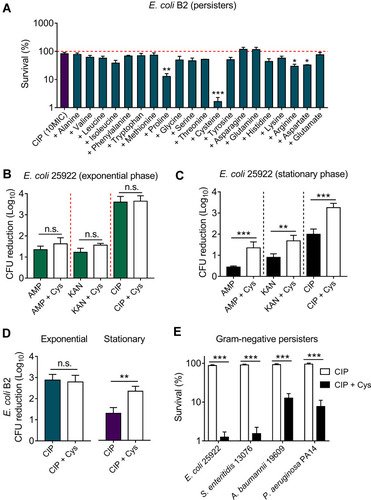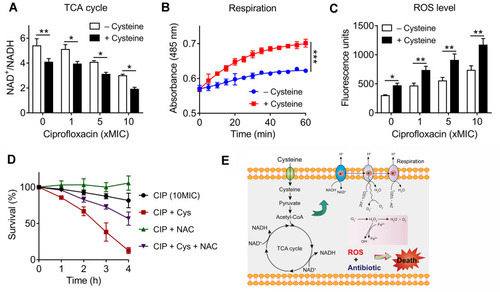Figures & data
Figure 1 Cysteine potentiates ciprofloxacin killing against stationary-phase bacteria and persisters, but not exponential-phase bacteria. (A) Effect of 20 L-amino acids (10 mM) on ciprofloxacin killing against E. coli B2 persisters. The initial persisters counts (CFUs/mL) were defined as 100% (red line). (B and C) Addition of cysteine (10 mM) has no effect on three bactericidal antibiotics activity in exponential phase (4 hours) antibiotic-sensitive E. coli ATCC 25922, whereas it significantly potentiates antibiotic activity against stationary phase bacteria (8 hours). (D) Cysteine (10 mM) improves ciprofloxacin activity against multi-drug resistant E. coli B2 in the stationary phase, but not in the exponential phase. (E) Cysteine improves ciprofloxacin killing against multiple Gram-negative bacterial persisters. All data were obtained in three independent experiments and are shown as mean±SD. n.s., not significant, *P<0.05, **P<0.01, ***P<0.001, determined by unpaired t-test.
Abbreviations: Cys, cysteine; AMP, ampicillin; KAN, kanamycin; CIP, ciprofloxacin.

Figure 2 Exogenous cysteine promotes bacterial respiration and production of reactive oxygen species (ROS). (A) Exogenous cysteine (10 mM) decreases the ratio of NAD+/NADH in the absence or presence of ciprofloxacin. (B) Enhanced bacterial respiration by exogenous cysteine (10 mM) during 60 minutes, determined by iodonitrotetrazolium chloride, a reduction-sensitive dye. (C) Addition of cysteine significantly triggers the production of ROS with or without ciprofloxacin, probed by 2′,7′-dichlorodihydrofluorescein diacetate (DCFH-DA). (D) ROS scavenger NAC counteracts the potentiation activity of cysteine with ciprofloxacin against E. coli B2 persisters. NAC, N-acetylcysteine. (E) Scheme of potentiation mechanisms of cysteine. Cysteine might be metabolized to pyruvate and further entry into the TCA cycle, then promotes the NADH production and bacterial respiration, triggers ROS production (partly from oxidation of cysteine), and thereby improves bactericidal lethality against bacterial persisters. All data in (A–D) were obtained in three independent experiments and areshown as mean±SD. *P<0.05, **P<0.01, ***P<0.001, determined by unpaired t-test.

